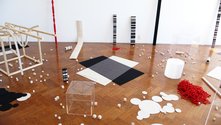John Hurrell – 16 March, 2012
The show is preoccupied with time and memory: the duration of viewer movement around the space; the length of time needed to link up the disparate elements with the displayed traces of their physical manufacture; the chronological nature of its many motifs, their origins within the artist's history and before; the salient signs of entropy and collapse - the shift from vertical to horizontal, the appearance of irreparable structural deterioration.
In more recent years Peter Robinson’s installations have usually consisted of densely packed forms made of hand carved or machine cut white polystyrene, so much so that the substance has almost become a Robinson brand. This new show has no polystyrene at all, and is a less claustrophobic, more airy presentation, an ostensibly ‘scatter’ (but really tightly organised) project made mostly with cut or stamped pieces of felt - with some perspex, wooden and wire elements that you can carefully walk amongst. Packed with references to earlier installations in his career trajectory - from the late nineties on - it alludes to exhibition sites like Venice, Lyons, Mebourne, Dunedin and Auckland, and seems a sort of taking stock, an evaluation of a certain thread within his thinking.
We see lots of enthusiasm for Barry Le Va, Robert Morris, Carl Andre and Sol LeWitt, references all mingled together, and no traces of other conspicuous heroes like Jean-Michel Basquiat, Franz West or Phillip Guston at all. All in a traditional ‘Maori’ palette of red, white, and black, with plenty of ‘blanket’ grey thrown in. It uses an even horizontal spread that emphasises lowly positioned shapes on the floor, but with felt ‘Cadere poles‘ leaning against the walls, reaching up to the ceiling.
Felt becomes a trope for dispersed, stacked or piled up replicated units, perspex a metaphor for layering of drawn compositions seen through or over each other, wood a symbol for linear rigidity, and wire a structure onto which many juxtapositions can be threaded in a row. Sometimes strange puns occur for apparent storage receptacles for information: reams of felt sheets become books and stacked perspex discs on rods, CDs. Microcosms and macrocosms extend side by side, big perspex cubes with tiny felt ones, heaps of perforated skeletal sheets near scattered much smaller discs.
There’s lots of paradox and Oldenburg-like humour when objects normally rigid in wood or plastic become soft in felt. Though stylistically a ‘scatter’ show, it’s basically a large (carefully planned) sprawling drawing on the floor with lots of linear or small solid objects. An earlier scatter (but also preplanning) artist like Le Va in 1967 made felt works in an attempt to ‘eliminate eye intimacy’ - being much influenced by the anti-retinal stance of Duchamp. Robinson’s use of felt on the other hand is motivated by the opposite impulse. It delights in rich intricate detail and the visually seductive, a bodily experience more than an idea that can be summed up in a verbal phrase and carried in the mind.
However the nature of that sensuality is complicated because intertwined within it is the conceptual content of the different referenced shows, and the viewer’s memory of their spaces - but all shuffled around and reblended. The wire armatures of Modern Standards (2011) now hold threaded on bar graphs or information codes; the stacked oval chains of Divine Comedy (2001), once red plastic forms that alluded to foundational units of the universe, are like ice cream biscuits with layers; the spilt toxic blobs from The Humours (2005) are now cute soft circles as if on the floor of a child’s nursery.
The show is preoccupied with time and memory: the duration of viewer movement around the space; the length of time needed to link up the disparate elements with the displayed traces of their physical manufacture; the chronological nature of its many motifs, their origins within the artist’s history and before; the salient signs of entropy and collapse - the shift from vertical to horizontal, the appearance of irreparable structural deterioration.
Maybe the prevalence of felt as a tactile source of bodily (ie. optical) comfort transmutes time and attendant memory to make Robinson’s show a comment on aging and the emotional softening of recall; a rueful observation as he the artist slowly advances (like us all) towards a Second Childhood. This if we are searching for metaphor or inverted pun, if we doggedly insist as such (even allowing it to be accidental); perhaps a comment on a mellowing in temperament and fading of harsh edges in mental picturing. If interpretation were mandatory?
John Hurrell











 Advertising in this column
Advertising in this column Two Rooms presents a program of residencies and projects
Two Rooms presents a program of residencies and projects



This Discussion has 0 comments.
Comment
Participate
Register to Participate.
Sign in
Sign in to an existing account.